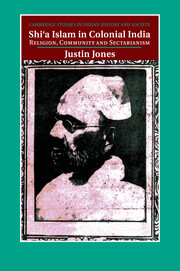Book contents
- Frontmatter
- Contents
- Figures and maps
- Preface and acknowledgements
- Frequently used abbreviations
- Note on transliteration
- Select glossary of terms
- Introduction
- 1 Madrasas, mujtahids and missionaries
- 2 Mosques, majalis and Muharram
- 3 Anjumans, endowments and Indian Shi‘ism
- 4 Aligarh, jihad and pan-Islam
- 5 The tabarra agitation and Shi‘a–Sunni conflicts in late colonial India
- Conclusion and epilogue Shi‘ism and sectarianism in modern South Asia
- Appendix Select Shi‘a ‘ulama of colonial India
- Select bibliography
- Index
Conclusion and epilogue - Shi‘ism and sectarianism in modern South Asia
Published online by Cambridge University Press: 05 November 2011
- Frontmatter
- Contents
- Figures and maps
- Preface and acknowledgements
- Frequently used abbreviations
- Note on transliteration
- Select glossary of terms
- Introduction
- 1 Madrasas, mujtahids and missionaries
- 2 Mosques, majalis and Muharram
- 3 Anjumans, endowments and Indian Shi‘ism
- 4 Aligarh, jihad and pan-Islam
- 5 The tabarra agitation and Shi‘a–Sunni conflicts in late colonial India
- Conclusion and epilogue Shi‘ism and sectarianism in modern South Asia
- Appendix Select Shi‘a ‘ulama of colonial India
- Select bibliography
- Index
Summary
If this book began with one moment of crisis for north Indian Shi‘ism, namely the 1860s–1870s, then the 1940s–1950s, which fall just outside its closing boundary, marked another. The partition of India meant that many of the Muslim zamindars and landed sayyids who had provided Shi‘ism with much of its economic patronage and cultural vigour left for Pakistan or elsewhere, while zamindari abolition put strain upon the Muslim notables who remained. This impoverishment of influential sections of the Shi‘a community was visible in the drying-up of the funds through which majlis gatherings and ta‘ziya processions had been held and orchestrated, meaning that Shi‘a Muharram became less exuberant in smaller towns, and to some degree even in Lucknow itself. Its impact on religious education was no less. The major madrasas discussed in this book, through which Shi‘ism was so substantially revitalized in colonial India, went into decline as financial donations dried up, as the largesse of the major benefactors of Rampur and Mahmudabad evaporated, as clerical qualifications were devalued, and as formerly landed scholarly families could simply no longer afford the luxury of a lifestyle of learning for their next generation.
In turn, this combined financial, cultural and educational pauperization of Indian Shi‘ism has also powerfully impacted upon its clergy. In contrast to the period discussed in this book, when as we have seen there were a large number of consensually accepted Shi‘a mujtahids even in Lucknow alone, modern South Asia as a whole has few mujtahids, most of whom in any case have their status or qualifications disputed by their opponents. Certainly none today are considered as holding the status of marja‘ or marja‘ ul-taqlid, as were some of the most exalted Lucknawi scholars until the 1930s–1940s. There are various reasons why the number of mujtahids and the standard of clerical guidance in India are widely perceived to have diminished. One is the absence of a madrasa in South Asia where one can pursue the dars-i-kharij, the curriculum to become a mujtahid. Another relates to the inaccessibility of the educational centres of Iraq to many Indian Muslims in much of the second half of the twentieth century, on account of a combination of financial limitation and Iraqi political instability. Another still relates to the decision by some major Indian Shi‘a mujtahids after independence to instruct their muqallids to confer their away from themselves and towards the more distant marji‘at of the scholars of Najaf.
- Type
- Chapter
- Information
- Shi'a Islam in Colonial IndiaReligion, Community and Sectarianism, pp. 222 - 242Publisher: Cambridge University PressPrint publication year: 2011



